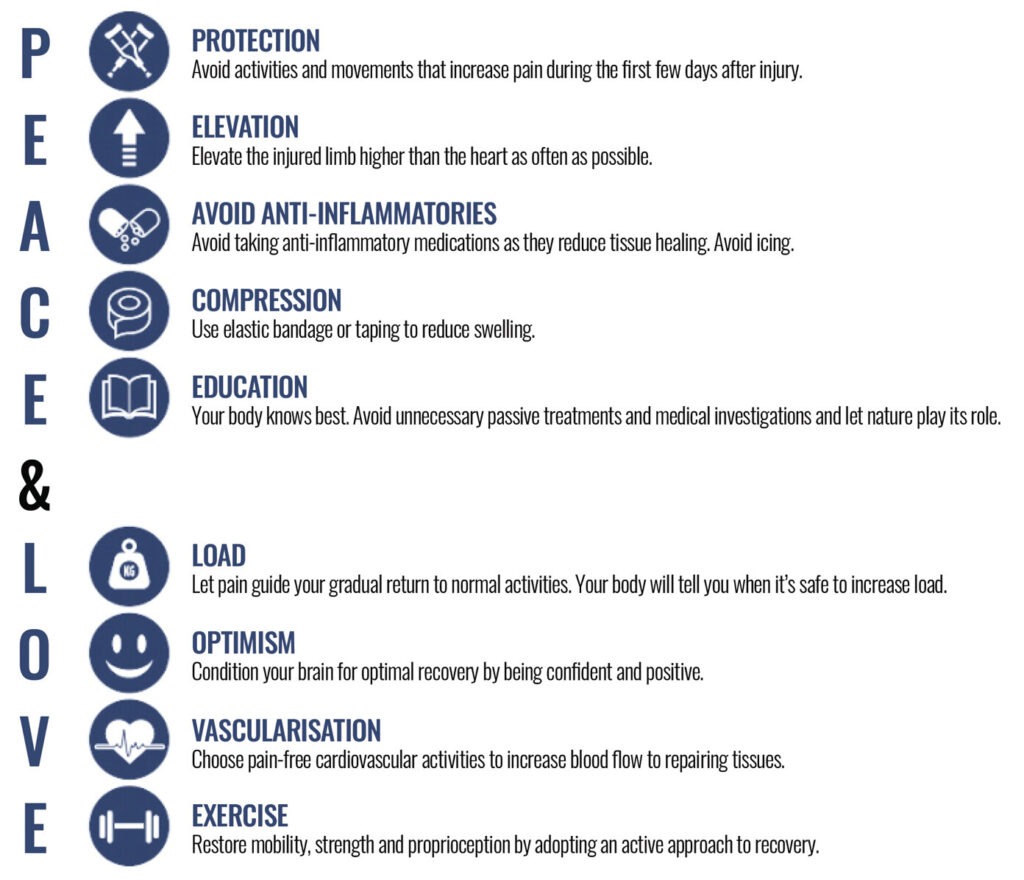In the realm of sports and fitness, injury management is a crucial aspect of maintaining peak performance and ensuring the well-being of athletes and enthusiasts alike. For decades, the RICER (Rest, Ice, Compression, Elevation, and Referral) protocol has been the go-to method for treating acute injuries. However, recent advancements in sports medicine and physiotherapy have shed light on its limitations and paved the way for more effective alternatives.
While the RICER protocol has undoubtedly served as a fundamental guideline in injury management, its efficacy has been increasingly questioned by experts in the field. Here’s why:
(R) Rest Isn’t Always the Best: The “Rest” component of RICER can often be taken a little too literal and may lead to prolonged immobilization of the injured area, which can impede the healing process and exacerbate the effects of inflammation in the body. Contrary to popular belief, complete rest may not be necessary or even beneficial for certain injuries. Instead, controlled movement and targeted exercises can promote circulation, tissue repair, and mobility, facilitating faster recovery.
(I) Ice May Delay Healing: Although ice application or cold therapy has been widely advocated for reducing inflammation and numbing pain, recent studies suggest that it may actually delay the healing process by constricting blood vessels and slowing down metabolic activity in the affected area. A study published in the Journal of Athletic Training by Costello et al. (2019) found that icing may hinder the body’s natural inflammatory response, which is essential for tissue repair, and could potentially delay recovery. Moreover, excessive icing can cause tissue damage and impair the body’s ability to heal properly.
(C) Compression and (E) elevation: As with many of these modalities, studies exist to support and refute use of compression. The quality of these studies can vary, however Miller et all (2019) discusses the benefits of compression garments in reducing oedema and swelling in various clinical settings, including postoperative care, venous insufficiency, and lymphedema management. Compression therapy is shown to enhance venous return, reduce fluid accumulation, and improve tissue healing, making it a valuable modality for managing swelling and promoting recovery even in the everyday soft tissue injury.
(R) Referral: The “Referral” aspect of RICER emphasizes the importance of seeking professional medical advice for severe injuries. What is important to remember in the interim is some of the basic self care management options may assist with reducing downtime and pain management.
The Peace and Love Protocol
The Peace and Love Protocol, introduced by Dubois and Esculier in 2019, expands upon traditional soft tissue injury management methods like RICE and POLICE. It emphasizes a holistic approach to soft tissue healing, encompassing both acute and long-term care.
PEACE, the initial phase, focuses on protecting the injured area to minimize further damage, elevating it to reduce fluid buildup, avoiding anti-inflammatory medications to support natural healing processes, and applying external compression to manage swelling. Additionally, patient education is crucial during this phase to promote active recovery and discourage over-reliance on passive treatments.
Transitioning to the LOVE phase, which follows the acute stage, involves gradually reintroducing movement and exercise. Loading the tissues appropriately, guided by pain tolerance, helps rebuild strength and resilience. Optimism plays a significant role in this phase, as psychological factors can influence recovery outcomes. Encouraging a positive mindset alongside cardiovascular activity promotes vascularization and overall tissue health. Finally, incorporating targeted exercises aids in restoring mobility, strength, and proprioception while minimizing the risk of recurring injuries.
Overall, the Peace and Love Protocol offers a comprehensive framework for soft tissue injury management, addressing not only immediate care but also long-term rehabilitation. By emphasizing patient education, appropriate loading, psychological support, and tailored exercise programs, it aims to optimize recovery outcomes and promote sustained tissue health. To understand a little more about the protocol lets look at each component.
PEACE
(P) Protect: Instead of complete rest, protect the injured area by avoiding activities that exacerbate pain or cause further damage. This may involve modifying movement patterns, using supportive equipment (such as braces or splints), or adopting alternative training modalities to maintain fitness levels without aggravating the injury but still keeping you moving.
(E) Elevate: Elevating the injured limb above heart level can help reduce swelling and promote venous return. However, this should be done intermittently and in conjunction with other active interventions rather than relying solely on elevation for symptom relief.
(A) Avoid Excessive Anti-inflammatory Modalities: Unlike RICER, the PEACE & LOVE protocol discourages the use of anti-inflammatory modalities such as ice, NSAIDs (Nonsteroidal anti-inflammatory drugs), and corticosteroid injections on initial injury but more with appropriate advice and assessment first. It emphasizes the body’s natural inflammatory response as a crucial component of the healing process and encourages strategies that support tissue repair and remodelling.
(C) Compressive Therapy: While compression is still part of the PEACE & LOVE protocol, its application is more nuanced and individualized based on the nature and severity of the injury. Compression garments or bandages may be used judiciously to manage swelling and provide support without compromising blood flow or tissue integrity.
(E) Education: Empowering individuals with knowledge about their injury, its underlying mechanisms, and effective self-management strategies is a cornerstone of the PEACE & LOVE protocol. By fostering a sense of ownership and agency over their recovery process, research shows that patients are more likely to adhere to treatment plans and actively participate in rehabilitation efforts. So if you’re not sure or your physio hasn’t explained their thinking and reasoning – just ask! Patient’s perspective is an integral part of the decision making process so lets chat!
LOVE
(L) Load: Contrary to traditional approaches that advocate for complete rest, the PEACE & LOVE protocol emphasizes the importance of progressive loading or unloading to stimulate tissue adaptation and enhance functional recovery. This involves gradually reintroducing movement, exercise, and physical activity tailored to the individual’s capabilities and tolerance levels.
(O) Optimism and Self-efficacy: Maintaining a positive mindset and believing in one’s ability to recover plays a crucial role in the rehabilitation process. The PEACE & LOVE protocol encourages practitioners to cultivate optimism and instill confidence in their patients, fostering a supportive environment conducive to healing.
(V) Vascularisation: Musculoskeletal injury management needs to include movement. More research is needed on specific dosage, but pain free activity is shown to elevate mood while also increasing blood flow to injured structures and may assist with reduced medication use.
(E) Exercise: While the intensity and type of exercise requires some additional thought, it is well supported in the current literature that patients are able to return to full function quicker with early mobility exercises. In a paper released in 2023 by Al-Janabi et al, controlled early range of motion exercises and weightbearing mobilisation was shown to improve outcomes, particular post surgical intervention for ankles.

So while the RICER protocol has been a longstanding paradigm in injury management, its efficacy and relevance in contemporary sports medicine are increasingly being called into question.
The PEACE & LOVE protocol offers a more comprehensive and evidence-based approach that prioritizes active rehabilitation, patient education, and individualized care. By embracing this paradigm shift and integrating modern principles of injury management into clinical practice, we can optimize outcomes and empower individuals to not only recover from injury but also thrive in their athletic pursuits.
Zoe Lorenzo
SENIOR PHYSIOTHERAPIST


